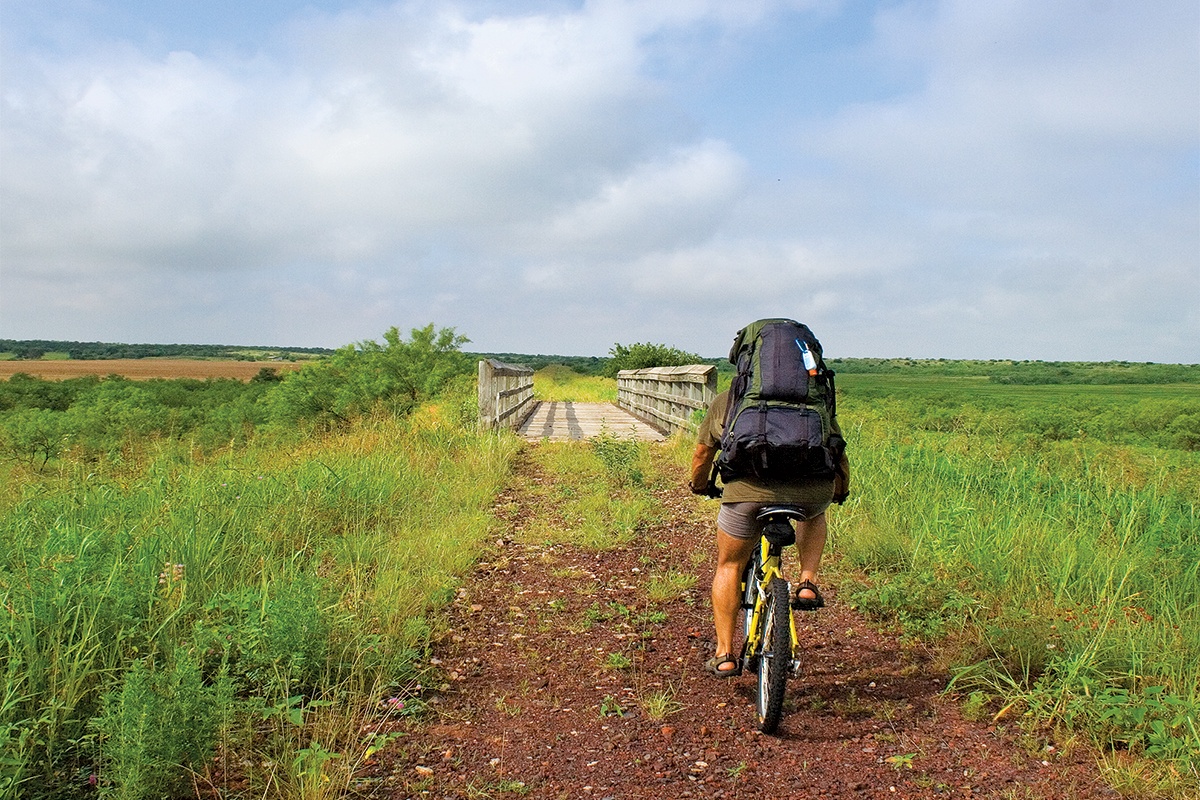Like many rural communities across the Panhandle, the town of Turkey (population 410) still depends on an all-volunteer fire department, the best food in town can be found at a family-owned and -operated café (Galvan’s), and a room at the local hostelry (the Hotel Turkey, built in 1927) can usually be secured at a moment’s notice.
Main Street, not surprisingly, is especially quiet on Sundays, and fried catfish, prepared by local volunteer groups such as the Lions Club, often serves as proxy in the town’s unofficial motto, “Love Turkey, Eat Fish,” particularly on fundraising nights.

Basketflowers grow in abundance along Quitaque Canyon Trail, a 17-mile leg of the Caprock Canyons Trailway.
E. Dan Klepper

A member of the official Texas state bison herd scratches an itch along the edge of park signage at Caprock Canyons State Park.
E. Dan Klepper
Turkey also is the boyhood haunt of country swing king Bob Wills. The town’s annual celebration, Bob Wills Day, attracts diehard fans of western swing, the musical style that once dominated charts and rural radio stations throughout the 1930s. A nostalgic sense of the ’30s still lingers in Turkey, particularly along its edges. Here, tidy streets end, plowed fields begin and red dirt farm-to-market roads lead you across the region’s agrarian backyard, through the broken rangeland of caprock country, and out of this century altogether.
A 10-minute drive east from Turkey along Texas 86 takes you to Quitaque (pronounced “kitty-kway” by some and “kitt-a-kway” by others), a community established in 1865 by Comanchero trader José Piedad Tafoya. Tafoya built a trading post here to exchange goods with the Comanches, and transactions often swapped ammunition for stolen livestock.
Quitaque is the gateway to Caprock Canyon State Park (home to the official Texas state bison herd) and the Caprock Canyons Trailway, a 64-mile multiuse hiking, biking and equestrian trail. The trailway, composed of the remaining berm of the abandoned Fort Worth and Denver South Plains Railway Line, is divided into six trail sections from 5 to 17 miles in length. It hosts eight trailheads accessible from farm-to-market roads and state highways, crosses 46 bridges and rolls over farms and brushy ranchlands before passing through Clarity Tunnel (home to migratory Mexican free-tailed bats), then climbs up and over the caprock escarpment on a 7 percent grade.
In addition to Turkey and Quitaque, the region offers plenty of other day-tripping destinations all within a few hours’ drive from Lubbock, including the community of Matador. Matador served as post office location for the historic Matador Ranch during the late 19th century and, today, hosts the restored Matador Hotel.

The restored Hotel Matador, the original cowboy hotel, was built in 1914. Today it serves as an eight-room bed-and-breakfast and weekend getaway for Panhandle Texans.
E. Dan Klepper

The Circle Cross Heritage Suite once served as a barbershop. The original white tin ceiling and wall-to-wall beveled mirrors remain. The bathtub that once served cowboys coming into town from area ranches for a weekly cleanup has been replaced with a walk-in shower and a large spa tub with room enough for two.
E. Dan Klepper
Built in 1914 and officially opened a year later as the Carter Hotel, this two-story mash-up of Prairie and Spanish Colonial Revival architecture occupies a small lot and garden along Matador’s Main Street. During its first decade, the hotel’s amenities included laundry service, a bellhop, manicured gardens and an ice cream parlor that occupied the entire length of the lobby.
The hotel had 15 rooms but only one bath with an oak-rimmed bathtub measuring 9 feet long (25 cents a bath). In the 1920s, the name was changed to Hotel Matador, and several decades later, barber Warren Clements bought the property, replacing the ice cream parlor with a barbershop featuring a tin ceiling and wall-to-wall beveled mirrors.
Today, it serves as an eight-room bed- and-breakfast with modern conveniences such as private bathrooms and wireless Internet. The hotel’s luxurious Circle Cross Heritage Suite replaced the barbershop but retains its wall-to-wall mirrors and white tin ceiling. The suite is also the former location of the oak-rimmed tub, and in its place the owners have installed a bathtub big enough for two.
Feel free to leave your hat on.


